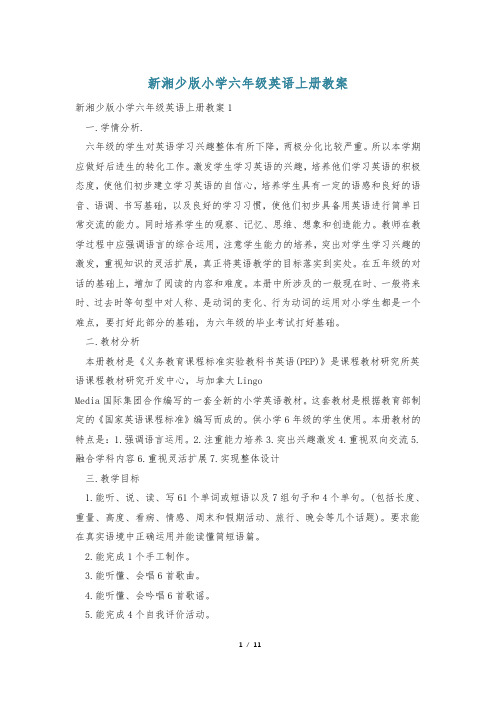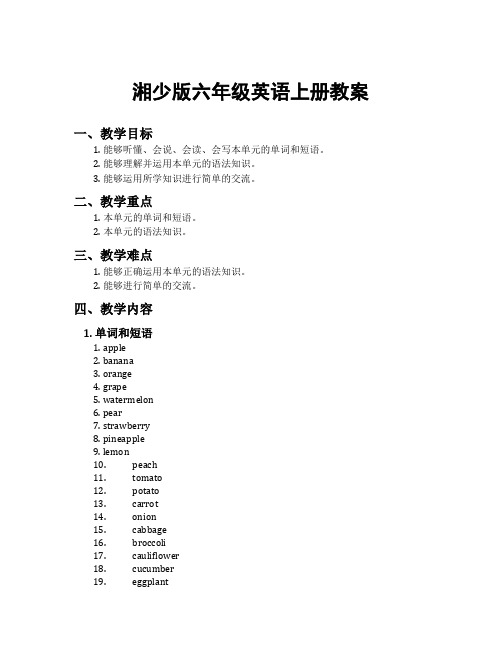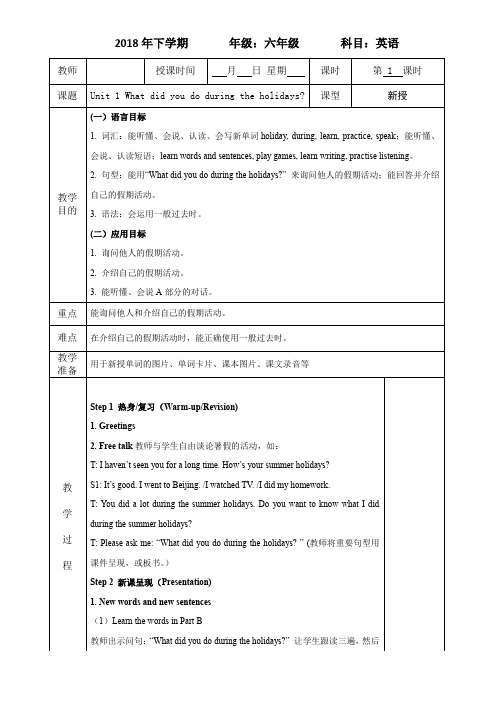2014秋新湘教版六年级英语上册教案
新湘少版小学六年级英语上册教案

新湘少版小学六年级英语上册教案新湘少版小学六年级英语上册教案1一.学情分析.六年级的学生对英语学习兴趣整体有所下降,两极分化比较严重。
所以本学期应做好后进生的转化工作。
激发学生学习英语的兴趣,培养他们学习英语的积极态度,使他们初步建立学习英语的自信心,培养学生具有一定的语感和良好的语音、语调、书写基础,以及良好的学习习惯,使他们初步具备用英语进行简单日常交流的能力。
同时培养学生的观察、记忆、思维、想象和创造能力。
教师在教学过程中应强调语言的综合运用,注意学生能力的培养,突出对学生学习兴趣的激发,重视知识的灵活扩展,真正将英语教学的目标落实到实处。
在五年级的对话的基础上,增加了阅读的内容和难度。
本册中所涉及的一般现在时、一般将来时、过去时等句型中对人称、是动词的变化、行为动词的运用对小学生都是一个难点,要打好此部分的基础,为六年级的毕业考试打好基础。
二.教材分析本册教材是《义务教育课程标准实验教科书英语(PEP)》是课程教材研究所英语课程教材研究开发中心,与加拿大LingoMedia国际集团合作编写的一套全新的小学英语教材。
这套教材是根据教育部制定的《国家英语课程标准》编写而成的。
供小学6年级的学生使用。
本册教材的特点是:1.强调语言运用。
2.注重能力培养3.突出兴趣激发4.重视双向交流5.融合学科内容6.重视灵活扩展7.实现整体设计三.教学目标1.能听、说、读、写61个单词或短语以及7组句子和4个单句。
(包括长度、重量、高度、看病、情感、周末和假期活动、旅行、晚会等几个话题)。
要求能在真实语境中正确运用并能读懂简短语篇。
2.能完成1个手工制作。
3.能听懂、会唱6首歌曲。
4.能听懂、会吟唱6首歌谣。
5.能完成4个自我评价活动。
6.能理解6个幽默小故事。
7.能了解6项简单的中西方文化知识。
四.教材重难点能按四会、三会的要求掌握所学单词。
能按四会要求掌握所学句型。
能使用日常交际用语,活用四会句型,进行简单的交流,做到大胆开口,发音正确。
(湘少版)六年级英语上册 《Unit14第一课时》教案设计

(湘少版)六年级英语上册 Unit14 第一课时教案设计一、教学目标•了解单词和短语的意思,能正确朗读和理解其上下文的意思。
•运用所学单词和短语,能够正确组织句子并表达意思。
•通过阅读文本,能够提取出关键信息并进行交流。
•能够通过与他人交流和合作,在小组活动中提升英语运用能力。
二、教学内容本节课将介绍有关“小组活动”的词汇和短语,通过交流和合作,在小组中提高英语的运用能力。
三、教学步骤1. 自我介绍和小组分组•每位学生在班级中自我介绍,并讲述自己喜欢的运动。
•老师将学生分为小组,每组4人。
2. 听力练习•播放录音,让学生跟读和理解单词和短语的意思。
单词和短语包括:teamwork、cooperation、communication、join、contribute、achievement。
•进行听力题目,帮助学生理解单词和短语的含义。
3. 阅读课文•学生读课文《Working Together in a Group》。
•学生回答问题,并提取出关键信息。
4. 小组活动•学生在小组内讨论和表达自己对团队合作的看法。
•学生在小组内练习使用所学单词和短语,构建句子和表达意思。
•学生在小组内进行角色扮演,模拟在团队中合作和协调。
5. 结束语•老师总结课堂所学内容,鼓励学生在以后的学习和生活中更好地运用所学知识。
•学生自我总结,分享自己的体验和感受。
四、课后作业•学生根据自己提取出的关键信息,写一篇简短的文章讲述自己对团队合作的看法和体验。
•老师布置下一次课前的学习任务,帮助学生更好地巩固所学知识。
五、教学评估本节课通过小组活动的方式,让学生实际运用所学知识,并和他人交流和合作。
学生在小组活动中是否能够成功运用所学知识和短语,以及他们所表达的交流和合作能力都可以作为教学评估的重要方面。
同时,学生的课堂表现和作业完成情况也可以作为评估的参考。
湘少版六年级英语上册教案

湘少版六年级英语上册教案一、教学目标1.能够听懂、会说、会读、会写本单元的单词和短语。
2.能够理解并运用本单元的语法知识。
3.能够运用所学知识进行简单的交流。
二、教学重点1.本单元的单词和短语。
2.本单元的语法知识。
三、教学难点1.能够正确运用本单元的语法知识。
2.能够进行简单的交流。
四、教学内容1. 单词和短语1.apple2.banana3.orange4.grape5.watermelon6.pear7.strawberry8.pineapple9.lemon10.peach11.tomato12.potato13.carrot14.onion15.cabbage16.broccoli17.cauliflower18.cucumber19.eggplant20.mushroom21.fish22.chicken23.beef24.pork25.rice26.noodles27.breadk29.juice30.water31.tea32.coffee33.sugar34.salt35.pepper36.butter37.cheese38.egg39.vegetable40.fruit41.meat42.drink43.eat44.like45.love46.want47.have48.need49.can50.cannot2. 语法知识本单元的语法知识为情态动词can和cannot的用法。
1.can表示“能够”,不能表示“会”或“应该”。
2.cannot表示“不能够”。
3. 教学步骤第一课时1.教师介绍本单元的单词和短语,并让学生跟读。
2.教师让学生进行听力练习,听到单词后进行说出。
3.教师让学生进行口语练习,让学生用所学单词进行简单的交流。
第二课时1.教师介绍本单元的语法知识can和cannot的用法。
2.教师让学生进行语法练习,让学生根据句子意思填写can或cannot。
3.教师让学生进行口语练习,让学生用can或cannot进行简单的交流。
湘教版小学六年级英语上册教案(全册)

Unit 1 The children are playing in the park.(孩子们正在公园里玩)Period 1一.教学目标1. 能听懂.会说新单词swing.slide.bench.bark.chain.bite.stones,2. 能理解课文,能正确运用现在进行时描述人物正在进行活动.二.教学重点及难点重点:掌握本单元四会单词.难点:理解课文.三.教学准备单词卡片和图片.教学挂图.教学磁带等.四.教学步骤Step 1 Warming up1. 师生问候.2. 唱已学的英文歌曲.Step 2 Presentation and drill1. T: Hello. boys and girls. Nice to see you again! Today is the first day of this new term. I`m very happy. So let`s go to the park together!边说边将一张公园大门的图片贴在黑板上.布置成公园的场景.2. 可出示一张秋千的图片.T: Look! A swing. Do you like it?板书单词swing.带读.将图片贴在黑板上[公园"的相应位置.3. 用同样的方法教单词slide和bench.4. 出示一张狗正在叫的图片.T: What is the dog doing? It is barking.板书单词bark.带读.T: Don`t throw the stones at the dog. It`ll bite you.板书单词stone和bite.并用动作帮助学生理解其含义.然后带读.5. 出示一张被铁链锁着的狗的图片.T,The dog always bites the strangers.so the owers use the chain.板书单词chain.帮助学生理解其含义.并带读.游戏--Look and say. (看看小说)教师做口型.学生根据口型说单词.游戏--Loud and low voice (大小声)教师大声说单词.学生小声重复,或者教师小声说.学生大声说.Step 3 Fast reading and listening1. 出示课文中人物的图片.T: Look! The children are playing in the park.边说边将图片贴在[公园"的相应位置.2. 快速阅读课文A部分.回答问题.T: Today we`ll learn Unit One. First let`s listen to the text. and then answer my question:Why is the dog biting Mingming`s foot检查学生阅读情况.帮助学生回答所提问题.Mingming is throwing stones at dog. so the dog is angry.3. 听课文A部分录音.模仿其语音.语调.掌握新词难句的正确读音.Step 4 Intensive reading1. 精读课文.然后两人一组完成课文C部分练习.2. 教师与学生校对答案后让学生按正确顺序读一遍.3. 听课文A部分录音.跟读.Step 5 Consolidation1.黑板上的单词卡片及图片复述课文.2.练习.(见<练习册>P1-3)Period 2一.教学目标1. 能复述课文A部分,2. 能正确运用现在进行时描述人物活动.二.教学重点及难点重点:理解现在进行时难点:正确运用现在进行时描述人物活动.三.教学准备让学生们准备一些生活照片.单词卡片.教学磁带等.四.教学步骤Step 1 Warming up1. 师生问候.2. 唱已学的英语歌曲.3. 利用卡片复习本单元新单词.游戏--Quick response (快速反应)教师说单词的中文.学生快速说出其英文,或者反过来.教师说英文.学生说中文.4. 复述课文.1) 两人一组进行复述2) 让一至两名学生上台复述.Step 2 Presentation and drill1. 学生自渎课文一遍.将课文中出现的现在进行时(如are playing. is sitting. is pushing. is playing等)划记出来.然后两人一组进行讨论.2. 教师总结.Step 3 Practice (课文D部分)1. 出示课文D部分图片或做动作.表情等.人学生两人一组看图或动作说句子.2. 小组活动.3. 完成书面练习.Step4 Consolidation1. 创设情景.自由会话.2.评价.3.家庭作业:听磁带.读课文.。
新版湘少版六年级上册英语教案

制定评价标准:明 确评价目标和内容, 制定评价标准和评 分细则
实施评价:根据评价 标准对学生的学习情 况进行评价,包括课 堂表现、作业完成情况、考试成绩等
反馈与改进:将评价 结果反馈给学生,帮 助学生了解自己的学 习情况,并根据评价 结果进行教学改进
总结与反思:对评价过 程进行总结,反思存在 的问题和不足,为今后 的教学提供参考和指导
添加标题
添加标题
添加标题
添加标题
情景教学:创设真实的语言环境, 让学生在实际情境中运用英语
探究学习:鼓励学生自主探究,培 养他们的创新思维和解决问题的能 力
利用多媒体教学软件,如PowerPoint、Flash等,制作生动有趣的课件 利用网络资源,如英语学习网站、在线英语课程等,丰富教学内容 利用音频、视频资源,如英语歌曲、英语电影等,提高学生听力和口语能力 利用互动教学工具,如互动白板、平板电脑等,增强学生参与度和学习兴趣
形成性评价:通过课堂表现、作业完成情况等对学生进行评价 总结性评价:通过期末考试、期中考试等对学生进行评价 自我评价:让学生对自己的学习情况进行自我评价 他人评价:让学生互相评价,或者让家长、老师对学生进行评价
评价内容:包括听说读写四个方面的能力 评价方式:采用多种形式,如课堂表现、作业完成情况、考试等 评价标准:根据学生的实际表现,制定合理的评价标准 评价反馈:及时向学生和家长反馈评价结果,以便改进教学
播放一段英语歌曲,激发学生的学习兴趣 展示一些与课程内容相关的图片或视频,引导学生进入学习状态 提出一些与课程内容相关的问题,引导学生思考并回答问题 介绍本节课的主要内容和学习目标,让学生了解学习任务和要求
引入新课:通过图片、视频等方式引入新课内容 讲解新词:讲解新单词的发音、含义和用法 讲解语法:讲解新语法点的用法和例句 练习巩固:通过练习题、游戏等方式巩固所学内容
新湘少版六年级上册英语教案

新湘少版六年级上册英语教案新湘少版六年级上册英语教案篇1【课题】第六单元 Lesson 31【重点】1.围绕本单元重点句式,针对画面进行充分的问答练习。
2.进一步确切掌握数字的读音及用法。
【难点】在就画面进行问答的过程中,对所学句式的综合运用。
【过程】1. warm-up / revision:1)日常口语会话。
2)游戏:猜猜数字:一个学生心里想一个数字,其他学生猜测:学生问:Is it …?这个同学根据别的同学的猜测进行判断,并用UP / DOWN 来提示。
看谁能够最先猜出这个数字。
在学生游戏过程中,教师要注意引导,纠正学生不正确的发音。
3)读一读:教师出示单词卡片,学生齐读或个人读单词,教师纠正发音。
教师注意倾听学生-teen和-ty 的读音。
4)听一听:教师口述,学生写出听到的数字。
2. Learn to say:1)学生打开书看一分钟,注意观察画面。
2)合上书,回忆你在画面上看到了什么?What did you see in the picture? 锻炼学生记忆力。
3)四个人为一个小组,互相交流曾看到了什么。
Please talk about what you see in the pictures in you groups.4)学生叙述看到的.东西,教师播放与课文配套的影片。
教师根据学生叙述的进程,点击画面,出现一些实物场景或图片。
教师引导学生回答:How many … are there in the picture?Where are they?教师提问:What colour is it / are they?回答后,再播放一遍影片。
5)教师此时可以面向学习上有困难的学生提问,引导他们复习提问的方法。
另外,可以进行如下活动:__ 教师可将画书中的图画分成几个区域,每个小组针对某一区域进行识图辨物的游戏。
同学间可以互相提问任何问题,不受教材提供的问题的限制,但强调不要用中文。
__ 小组汇报本组谈论的情况。
新湘少版六年级上册英语教案完整版

新湘少版六年级上册英语教案集团标准化办公室:[VV986T-J682P28-JP266L8-68PNN]Unit 1 What did you do during the holidays?Period 1一、Teaching aims1.Enable the Ss listen, read, say and write the new words: learn words and sentences, , learn writing and price listening.2.Enable the Ss be familiar with the past tense.3.Sentence: What did ...do during the summer holidays二、Teaching emphasis: Enable the Ss listen, read, say and write the new words and talk about the past events.三、Teaching difficulties: Enable the Ss be familiar with the past tense.四、Teaching : Tape, pictures五、Teaching method Oral method六、Teaching steps:Step 1 Warming up1.Greetings and . Simon says: word list-, learn, write, talk, listen, do, have, go, take, read, speak, teach and holidays.2.Make a conversation with the Ss. T: Glad to see you again. Ss:Glad to see you too. T: What did you do during the summer holidays Ss: I went to Haina n…Step 2 Presentation and drill1. Show the picture of “learn words and sentences”. T: This is a picture of Mingming during the summer holidays. What did he doSs: He is learning words and sentences.T: He is not doing it now. He learnt words and sentences during the summer holidays.2.Learn the other words in the same way.3.Read together.4.Little teacher.Step 3 PriceT: He learnt words and sentences. They ed . She learnt writing. He practised listening. (Action) learn words and sentences, play games, learn writing and practice listening…3.The Ss act and say.4. Listen to the tape of Part A and then answer these questions. What Anne do during the summer holidays What did Mingming do during the summer holidays 3. Listen and repeat.5.Act it out.Step 4 Consolidation 1. Evaluation. 2. Do Ex. 3.Homework. Copy the new words. Design of the blackboard:Period 2一、Teaching aims:1. Enable the Ss listen, read and say the dialogue;2.Enable the Ss the sentence pattern: What you do during the holidays3.4.5.Enable the Ss master read the short passages and judge True or False.二、Teaching emphasis: Enable the Ss listen, read and say the dialogue;三、Teaching difficulties: Enable the Ss master the sentence pattern: What did you do during the holidays四、Teaching : Tape, pictures五、Teaching method Oral method六、Teaching steps:Step 1 Warming up1. Greetings.2.Act and say. 1). (Action) learn words and sentences, , learn writing and price listening… 2). Tom: I played games. Ss: Tom played games. …Step 2 Presentation and drill 1. Listen to the tape and learn the Word Bank. What you do during the holidaysI read many books. I visited my grandparents. I played games with my friends.Step 3 Practice1. Listen to the tape and repeat.2. Pair-work.3.Group-work .Step 4 Let’s Read1.Read the short passage and then judge True or Flase.2.Read the passage again and underline the key sentences.3.Check the answers.Step 5 Consolidation1. Evaluation.2.Do Ex3. Homework. Design of the blackboard:Period3一、Teaching aims:1. Enable the Ss talk about their holidays.2. Enable the Ss and write down their holidays.二、Teaching emphasis: Enable the Ss describe their holidays.三、Teaching difficulties: Enable the Ss to talk about and write down their holidays四、Teaching : Tape五、Teaching method Oral method六、Teaching steps:Step 1 Warming up1.Greetings.2.Read Part A together.3.Step 2 Presentation and drill4.5.1. Ask students to talk about their summer holidays and then let them finish Part E: write down your answers2.Check the answer.3. Ask two Ss to talk about their answers.Step 3 Let’s Have Fun1.Class work. Look at the pictures, describe Mingming’s and Anne’s holidays.2. Class work. describe your holidays.Step 4 Consolidation1.Do Ex. Workbook Unit 1.2. Evaluation3. Homework. Revise Unit 1. Design of the blackboard:2、Katie always gets up early.Period 1Teaching aims.1.The aims of knowledge:Learn these new words: wake up; make the bed; wave; latealways; usually; often; never.2. The aims of skills:a. Ss can understand the four –skill words: wake up; makethe bed; wave; lateb. Ss can understand the words: always; usually; often; never.c. Ss can describe the other’s actions.3.Emotion, attitudes and valueTo form the health living habitMain points and difficult point:The students master the words: wake up; make the bed; wave; late; always; usually; often; never.Teaching method and Learning way:TPR; Task-based method; DiscussingTeaching aids :Cards, tape ,record, picturesTeaching Process:Step 1 Warming upa. Greetings.b. sing a song: London Bridge is falling downc. Free talk. Talking about my day.Step 2 Reviewa. Game—Guess ,guess, guessUse the cards to go over the wordsb. I usually at 6.make the bede.g. a. Do she in morning?b. first thing he does after getting up is to .a greeting挥手致意good-bye to sb.挥手告别late.e.g. I’m lateautumn暮秋, 深秋get up 睡懒觉b. Let the students understand frequency Adverbs(频率副词):always often usually never alwaysRead these words several times and try to remember them. At the same time, explain the meanings of different adverbs of frequency.100% alwaysI always stay at home in the evenings.90% usuallyI usually wake up early.80% oftenHe often goes to school on foot.0% neverHe never goes to school late.Step 3. PracticePractice the words.a. Game 1. Loud and low voice.b. Game 2. Quick responseThe teacher brings out some pictures and word cards, the students speak out the words quickly.c. Game 3. Guessing gameWriting on blackboard:2、Katie always gets up early.c a k ew a k e wake upm a k e make the bed.w a v el a t ePeriod 2Teaching aims:A. Knowledge and skillsa. Learn Part A Let’s listen and say. Katie’s Day.b. Grasp the usage of adverbs of frequency.B. Processes and methodsa. With the studying strategies, get the students to work in pairs or groups to talk about their day.b. Let the students practice speaking and writing.C. Emotion, attitudes and valueThe content of this part is close to the students’daily life and the topic deals with the students’ daily activities, so it is helpful for the students to learn about more daily activities. It can help the students to carry on the language practice about the topic and to arouse their great interest in learning English; On the other hand, it provide the students with opportunities to understand one another better.Teaching difficulties and focuses:a. Ss can use the present tense of the third personget-gets make-makes wash-washes run-runs leave-leaves have-hasb. Ss can master sentence structure: sb do sth at some timeTeaching method:Task-based Learning MethodTeaching aids:Cards, recorder and some objectsTeaching Process:Step 1 Warming upa. Greetings.b. sing a songStep 2ReviewGame—Golden fingerUse the cards to go over the wordsStep 3 Presentation and drilla. Listening to the recorderb. T: You’re very good. You are all good pupils. And Katie is a good pupil too. Everyone likes her. She is never late for school. She always gets up early every day . Then she makes bed .after breakfast, she waves her family goodbye.c. Fast reading the text.d. Answer the following questions.Does Katie always gets up early?What time does Katie wash her face?What time does Katie make her bedIs Sally is often late?What time does Katie’s father leave for workc. Retell it , check the resultd. Practice in pairs, according to the form to say something about their day.Step5 Consolidationa. Part C About the story.Put a tick(√)if the sentences correct of a cross(×)if they are wrong.1.Katie always gets up at six o’clock. (√)2.Katie always washes her face at 6:15 am. (×)3.Katie’s family often has breakfast at 6:45 am.(×)4.Sally always goes to the breakfast table on time.(×)5.Katie’s father usually waves then goodbye. (√)b. Homework: Listen and read the dialogue, copy thenew wordsWriting on blackboard:2、Katie always gets up early.get - getsmake - makeswash - washesrun - runsleave - leaveshave - hasPeriod 3Teachingaims.a. Going over words.b. Retell the story.c. Finish Part D, E, F.Main points:b. Homework: Listen and read the dialogue, copy the words ,and try to recite text。
湘少版小学六年级上册英语全册教案(表格式)

Step 1 热身/复习(Warm-up/Revision)1. Greetings2. Watch a video教师播放一段关于电脑功能的视频。
学生看后,能够明白今天这节课所要讨论的主题。
3. Free talk教师用“I have a computer. I always prepare the lesson with the computer. What do you usually do on computer?”来让学生说说他们平常用电脑做些什么。
Step 2 新课呈现(Presentation)1. New words and new sentences(1) Learn the words in Part B教师出示一幅人物图片,让学生猜猜他是谁。
在学生说出他是谁和他的一些事迹以后,教师进一步与学生交流:在小时候乔布斯就希望自己长大后能设计出可以email his friends(出示图片帮助学生理解) , send greetings, search for a lot of things and find out about countries (后几个短语用同样的方法进行教学) 的电脑。
教师边说边将这几个短语出示在课件上并教学生读。
(如果是农村学校,教师可以用卡片代替) 教师还可以根据学生的情况适当增加一些短语,如finish the homework, see the movies, read many books, play games。
学生朗读这些短语。
教师出示电脑的图片,请学生说一说它能做什么。
Step 1 热身/复习(Warm-up/Revision)1. Greetings2. Free talk这段时间我们学习了哪些知识,说说你记得的。
学生回答,教师梳理总结。
3. Brainstorming学生根据教师所给的主题词,说出相关联的单词或短语。
4. Revision(1) Review in groups学生在小组中分析各个单元的重点单词和句型,并将其梳理制作成复习要点。
- 1、下载文档前请自行甄别文档内容的完整性,平台不提供额外的编辑、内容补充、找答案等附加服务。
- 2、"仅部分预览"的文档,不可在线预览部分如存在完整性等问题,可反馈申请退款(可完整预览的文档不适用该条件!)。
- 3、如文档侵犯您的权益,请联系客服反馈,我们会尽快为您处理(人工客服工作时间:9:00-18:30)。
Unit1 What did you do during the holidays? Teaching Goals:1.Learn new words.2.Learn the text.3.Know the Past Form of the verbs.Teaching Point:Master the Past Form of the verbs.Teaching Preparations:Tape and picturesTeaching Process:1.Warming Up(1)Greetings(2)The students talk about their summer holidays.2.Presentation and Drills(1)Learn new wordsduring holiday learn practise speak(2)Learn Part ALet’s Listen and SayRead the text.What did you do during the holidays?I learnt writing.What are you reading?I’m reading an English storybook.(3)Learn Part Blearn words and sentences play gameslearn writing practise listening (4)Learn Part CLet’s PractiseWhat did you do during the holidays?I read many books.Master the Past Form of the verbs.talk—talked practice—practised listen—listeneddo—did have—had go—went learn—learnttake—took read—read speak—spoke teach—taught write—wrote visit—visited play—playedUnit1 What did you do during the holidays? Teaching Goals:1.Review the words.2.Review the text.3.Review the Past Form.4.Can do the exercises.Teaching Point:Master reading skill.Teaching preparations:Exercises and pictures.Teaching Process:1.Warming Up(1)Greetings(2)Review2.Presentation and Drills(1)Learn Part DLet’s ReadRead the text of Part D.Do the exercises of Part D.Talk about Part D.(2)Learn Part ELet’s WriteWrite down your answers.What did you do during the summer holidays?I went .What did you learn?I learnt .What did you read?I read .What did you listen to?.What did you write?.(3)Learn Part FLet’s Have Fun.Talk about your holidays.Unit2 Katie always gets up early. Teaching Goals:1.Learn new words.2.Learn the text.3.Master the Third Person Singular.Teaching Point:Master the Third Person Singular.Teaching Preparations:Tape and pictures.Teaching Process:1.Warming Up(1)Greetings(2)Review2.Presentation and Drills(1)Learn new words.always weekday often afterwave return sometimes never(2)Learn Part ALet’s listen and SayKatie’s day1>Read the text.Katie always gets up early.Katie returns home at 5:00 p.m.She plays chess with her father after dinner.2>The Third Person Singularget—gets have—has wave—waves go—goesreturn—returns do—does play—plays3>Short Phrasesget up have breakfast go to schoolreturn home do homework play chess(3)Learn Part Bwave goodbye be late for school do her homework read a newspaper play chess take a walk(4)Learn Part CLet’s PractiseGroup work. Talk about Peter’s activities.Unit2 Katie always gets up early. Teaching Goals:1.Review the words.2.Review the text.3.Review the Third Person Singular.4.Can do the exercises.Teaching Point:Master reading skill.Teaching Preparations:Exercises and picturesTeaching Process:1.Warming Up(1)Greetings(2)Review2.Presentation and Drills(1)Learn Part DLet’s ReadRead the text of Part D.Do the exercises of Part D.Talk about Part D.(2)Learn Part ELet’s WriteFill in the blanks.I always .I often .I sometimes .I never .(3)Learn Part FLet’s Have FunLet’s rhyme.The snail says,” I feel nice,I love my shell.When I see mice,I go into my shell,I always carry my house about.”The bird says,” I’m always free!I’m never sad!I like the tree.Resting on my nest is not bad.”Unit3 I like my computer Teaching Goals:1.Learn new words.2.Learn the text.3.Master the Past Form.Teaching Point:Master the Past Form.Teaching Preparations:Tape and picturesTeaching Process:1.Warming Up(1)Greetings(2)Review2.Presentation and Drills(1)Learn new wordssearch find out about worldemail send greeting(2)Learn Part ALet’s listen and Say1>Read the text.I like my computer.It’s very fast. It will help you a lot.You can also find out about countries in the world.Let’s try it now.2>The Past Formbuy—bought is—wascan—could see—saw(3)Learn Part BLet’s Learnemail my friends send greetingssearch for a lot of things find out about countries (4)Learn Part CLet’s PractiseWhat can we do on the computers?We can email each other.We can send greetings to our friends.We can search for a lot of things.Unit3 I like my computer Teaching Goals:1.Review the words.2.Review the text.3.Review the Past Form.4.Can do the exercises.Teaching Point:Master reading skill.Teaching Preparations:Exercises and picturesTeaching Process:1.Warming Up(1)Greetings(2)Review2.Presentation and Drills(1)Learn Part D.Let’s ReadRead the text of Part D.Do the exercises of Part D.Talk about Part D.(2)Learn Part E.Let’s WriteWrite on email to your friend. Tell him/ her what you did last Sunday.Dear ,Last Sunday, I had a wonderful day. I played with my friends 9:00 a.m. After the games, I my homework on the computer. The teacher emailed us about homework. It’s easy to homework this way. In the afternoon, I a short cartoon film on the computer.That’s all for now.Regards,(3)Learn Part FLet’s Have FunLook and make.Let’s Know MoreTeaching Goal:Know something about travelling around China.Teaching Point:Know something about travelling.Teaching Preparations:Some important informations and picturesTeaching Process:1.Warming UpGreetings2.Presentation and Drills(1)Read the text on Page 13.Changsha South Railway StationA bus station in ChengduShanghai Pudong AirportTianjin Port(2)Talk about your travelling during the summer holidays.Assessment ⅠTeaching Goals:1.Review the last class.2.Can do the exercises.Teaching Point:Do the exercises.Teaching Process:1.Warming UpGreetingsReview2.Presentation and Drills(1)Listen and tick(2)Listen and circle(3)Read and fill in the blanks(4)Read and write(5)I can do it(6)I like to do itUnit4 The Mid—Autumn Festival is comingTeaching Goals:1.Learn new words.2.Learn the text.3.Know the Mid—Autumn Festival.Teaching Point:Know the Mid—Autumn Festival.Teaching Preparations:Tape and picturesTeaching Process:1.Warming Up(1)Greetings(2)Review2.Presentation and Drills(1)Learn new wordsthe Mid—Autumn Festival nearby centre mooncaketype lotus seed bean taste(2)Learn Part ALet’s listen and SayRead the text.The Mid—Autumn Festival is coming.Mrs Li and her son, Binbin, go shopping at the nearbyshopping centre.Which type do you like?I like the ones with lotus seeds.How much is a box of mooncakes?(3)Learn Part BLet’s learnmooncake nuts lotus seed red bean (4)Learn Part CLet’s PractiseI enjoy eating the lotus seed mooncakes.I enjoy looking at the moon.I enjoy reading poems when looking at the moon.I enjoy drinking tea.Unit4 The Mid—Autumn Festival is comingTeaching Goals:1.Review the words.2.Review the text.3.Can do the exercises.Teaching Point:Master reading skill.Teaching Preparations:Exercises and picturesTeaching Process:1.Warming Up(1)Greetings(2)Review2.Presentation and Drills(1)Learn Part DLet’s ReadRead the text of Part D.Do the exercises of Part D.Talk about Part D.(2)Learn Part ELet’s WriteYesterday was the Mid—Autumn Festival. You had a good timein the evening. What did your family do? Write about it.We celebrated the Mid—Autumn Festival at home. Weand . We enjoyedand . My grandfather told .We were very interested in them.(3)Learn Part FLet’s Have FunIn the moze on the book, find out what each person has to celebrate the Mid—Autumn Festival.Unit5 It will be sunny and cool tomorrow Teaching Goals:1.Learn new words.2.Learn the text.3.Master the Future Tense.Teaching Point:Master the Future Tense.Teaching Preparations:Tape and picturesTeaching Process:1.Warming Up(1)Greetings(2)Review2.Presentation and Drills(1)Learn new wordsforecast clear light rain heavy(2)Learn Part ALet’s Listen and SayRead the text.It’s time for the weather forecast.Tomorrow will be clear in Beijing.It will be sunny and cool.There will be a strong wind in Xi’an.It will rain tomorrow in Changsha.But it won’t be heavy.It will be sunny and warm in Sanya.(3)Learn Part BLet’s Learnweather forecast light rain sunny and warmstrong wind heavy rain sunny and cool light snow (4)Learn Part CLet’s PractiseIt will be sunny tomorrow.There will be a light snow next Friday.Unit5 It will be sunny and cool tomorrow Teaching Goals:1.Review the words.2.Review the text.3.Review the Future Tense.Teaching Point:Master reading skill.Teaching Preparations:Exercises and picturesTeaching Process:1.Warming Up(1)Greetings(2)Review2.Presentation and Drills(1)Learn Part DLet’s ReadRead the text of Part D.Do the exercises of Part D.Talk about Part D.(2)Learn Part ELet’s WriteRead and writeTomorrow will be in Changsha.There will be in .It will be .It will .(3)Learn Part FLet’s Have FunLet’s sing the song “Itsy Bitsy Spider”Unit6 I will bring a big bottle of orange juice Teaching Goals:1.Learn new words.2.Learn the text.3.Master the future tense.Teaching Point:Master the future tense.Teaching Preparations:Tape and picturesTeaching Process:1.Warming Up(1)Greetings(2)Review2.Presentation and Drills(1)Learn new wordsbring bottle picnic fruit barpeanut candy wait can(2)Learn Part ALet’s Listen and SayRead the text.Autumn is coming. The weather is getting cool and nice.What are we going to bring for the picnic?I will bring a big bottle of orange juice.I will bring some peanuts and candies.(3)Learn Part BLet’s Learna bottle of orange juice a box of cakesa few cans of Coke a few bars of chocolatebring meet peanut fruit candy (4)Learn Part CLet’s PractiseI will bring a bottle of orange juice.I will bring a few cans of Coke.I will bring a can of Coke.I will bring three bottles of milk.Unit6 I will bring a big bottle of orange juice. Teaching Goals:1.Review the words.2.Review the text.3.Review the future tense.4.Can do the exercises.Teaching Point:Master reading skill.Teaching Preparations:Exercises and picturesTeaching Process:1.Warming Up(1)Greetings(2)Review2.Presentation and Drills(1)Learn Part DLet’s ReadRead the text of Part D.Do the exercises of Part D.Talk about Part D.(2)Learn Part ELet’s WriteLingling’s family wants to go to the beach for a picnic. Write down what her family will bring to the beach.Lingling’s father will .Lingling’s mother .Dongdong .Lingling . (3)Learn Part FLet’s Have FunLook at the pictures on the book and write down the items.Let’s Know More Teaching Goals:Know something about picnic. Teaching Point:Know something about picnic. Teaching Preparations:Important informations and pictures Teaching Process:1.Warming UpGreetings2.Presentation and Drills(1)Read the text on Page 29.(2)Some picnics and partiesTeddy Bears’ Picnic (USA)Easter Egg Hunt (UK)Beach party ( Australia)Assessment ⅡTeaching Goals:Can do the exercises. Teaching Point:Do the exercises.Teaching Preparation:TapeTeaching Process:1.Warming UpGreetings2.Presentation and Drills(1)Listen and circle(2)Listen and number(3)Look and write(4)Read and write(5)I can do it(6)I like to do itUnit 7 What can I do?Teaching Goals:1.Learn new words.2.Learn the text.3.Master the sentence pattern” What can…..do?”Teaching Point:Master the sentence pattern” What can….do?”Teaching Preparations:Tape and picturesTeaching Process:1.Warming Up(1)Greetings(2)Review2.Presentation and Drills(1)Learn new wordsweak slow(2)Learn Part ALet’s Listen and SayRead the text.The children want to help old people.I can make tea or coffee for them.What can I do?I can clean their houses.I can sing to them and make them happy.(3)Learn Part BLet’s Learnan old woman help old people on the road make tea make cakesclean their homes make them happy(4)Learn Part CLet’s PractiseWhat can I do?I can make them happy.I can help them on the road.Unit 7 What can I do? Teaching Goals:1.Review the words.2.Review the text.3.Review the sentence pattern” What can…..do?”4.Can do the exercises.Teaching Point:Master reading skill.Teaching Preparations:Exercises and picturesTeaching Process:1.Warming Up(1)Greetings(2)Review2.Presentation and Drills(1)Learn Part DLet’s ReadRead the text of Part D.Do the exercises of Part D.Talk about Part D.(2)Learn Part ELet’s WriteI can help old people .I am going to tell them .I would like to .I can .I like to .(3)Learn Part FLet’s Have FunLet’s chant.Every day, he sits there alone.No one cares. No one comes near.His heart is cold, like a stone.But he will have some happy tearsWhen you simply say” Hello.”Unit 8 We shouldn’t waste water Teaching Goals:1.Learn new words.2.Learn the text.3.Master the sentence pattern “We shouldn’t ……”Teaching Point:Master the sentence pattern “We shouldn’t ……”Teaching Preparations:Tape and picturesTeaching Process:1.Warming Up(1)Greetings(2)Review2.Presentation and Drills(1)Learn new wordsshould shouldn’t= should not waste blouseenough save drop fresh(2)Learn Part ALet’s Listen and SayRead the text.What are you doing?I’m washing my blouse.We shouldn’t waste water.Why? You need water.Everyone needs water.(3)Learn Part BLet’s Learnkeep the rivers clean keep the air clean and fresh plant more trees use bikes instead of cars shouldn’t kill wild animalsshouldn’t waste water shouldn’t litter(4)Learn Part CLet’s PractiseWe should plant more trees.We shouldn’t waste water.We shouldn’t kill wild animals.Unit 8 We shouldn’t waste water. Teaching Goals:1.Review the words.2.Review the text.3.Review the sentence pattern “ We shouldn’t….”4.Can do the exercises.Teaching Point:Master reading skill.Teaching Preparations:Exercises and picturesTeaching Process:1.Warming Up(1)Greetings(2)Review2.Presentation and Drills(1)Learn Part DLet’s ReadRead the text of Part D.Do the exercises of Part D.Talk about Part D.(2)Learn Part ELet’s WriteLook at the picture on the book. Write a few sentences about it. There are on the road.We can go to school or .In the morning many people go to work .In the evening many people .(3)Learn Part FLet’s Have FunGet some pictures like those on the book.Talk about the pictures.Work in groups. Design a poster. Use the words “ should “ and “ shouldn’t”.Unit 9 This bird is bigger than the first one Teaching Goals:1.Learn new words.2.Learn the text.3.Master the Comparative/ Superlative form of adj. and adv. Teaching Point:The Comparative/ Superlative form of adj. and adv. Teaching Preparations:Tape and picturesTeaching Process:1.Warming Up(1)Greetings(2)Review2.Presentation and Drills(1)Learn new wordsthan clay(2)Learn Part ALet’s Listen and SayRead the text.Children’s clay art is on show at Sunshine school.This is the first one. It’s a small bird.This is the second one.This bird is bigger than the first one.Look at the third bird!It’s bigger than the second one.(3)Learn Part BLet’s Learnbig—bigger—biggest small—smaller—smallest tall—taller—tallest short—shorter—shortest long—longer—longest(4)Learn Part CLet’s PractiseTom is taller than Mike.Tom’s hair is shorter than Mike’s.Unit 9 This bird is bigger than the first one Teaching Goals:1.Review the words.2.Review the text.3.Review the Comparative/ Superlative degree of adj. and adv..4.Can do the exercises.Teaching Point:The Comparative/ Superlative degree of adj. and adv.. Teaching Preparations:Exercises and picturesTeaching Process:1.Warming Up(1)Greetings(2)Review2.Presentation and Drills(1)Learn Part DLet’s ReadRead the text of Part D.Do the exercises of Part D.Talk about Part D.(2)Learn Part ELet’s WriteFill in the blanks.Peter is . David runs .Peter runs . Peter can jump .David can . John .(3)Learn Part FLet’s Have FunLet’s chantThe giraffe says, “ I am taller.”The little rabbit says, “I am faster.”The elephant says, “I am bigger.”The monkey says, “I am smarter.”The lion says, “I roar louder!And I feel prouderThan you!”。
